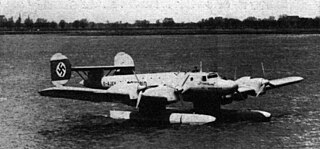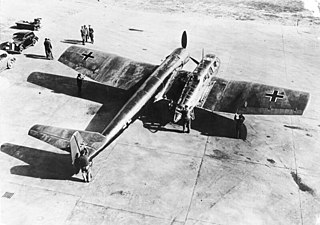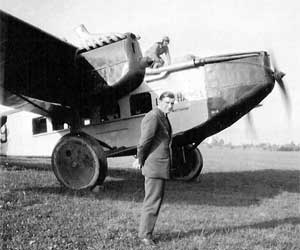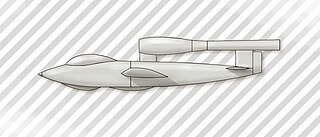
The Focke-Wulf Fw 200 Condor, also known as Kurier to the Allies, is an all-metal four-engined monoplane designed and produced by the German aircraft manufacturer Focke-Wulf. It was the first heavier-than-air craft to fly nonstop between Berlin and New York City, about 4,000 miles (6,400 km), making the flight from Berlin-Staaken to Floyd Bennett Field on 10/11 August 1938 in 24 hours and 56 minutes.

The Henschel Hs 129 was a ground-attack aircraft designed and produced by the German aircraft manufacturer Henschel Flugzeugwerke AG. Fielded by the Luftwaffe during the Second World War, it saw combat in Tunisia and on the Eastern Front.

The Blohm & Voss BV 155 is a German high-altitude interceptor aircraft intended to be used by the Luftwaffe against raids by USAAF Boeing B-29 Superfortresses. Work started on the design as the Messerschmitt Me 155 in 1942, but the project went through a protracted development period and change of ownership, and prototypes were still under test and development when World War II ended.
Hamburger Flugzeugbau (HFB) was an aircraft manufacturer, located primarily in the Finkenwerder quarter of Hamburg, Germany. Established in 1933 as an offshoot of Blohm & Voss shipbuilders, it later became an operating division within its parent company and was known as Abteilung Flugzeugbau der Schiffswerft Blohm & Voss from 1937 until it ceased operation at the end of World War II. In the postwar period it was revived as an independent company under its original name and subsequently joined several consortia before being merged to form Messerschmitt-Bölkow-Blohm (MBB). It participates in the present day Airbus and European aerospace programs.

The Heinkel He 70 Blitz ("lightning") was a fast monoplane aircraft designed and produced by the German aircraft manufacturer Heinkel Flugzeugwerke. It was the first Schnellbomber operated by the Luftwaffe.

The Blohm & Voss BV 40 was a prototype armoured German glider initially designed in mid-1943 by Blohm & Voss to attack Allied bomber formations during World War II. The BV 40 would be towed to high altitude by single-engined fighters and then ram the bombers while in a dive, but this concept was rejected before its first flight in May 1944 in favour of using its guns. The Luftwaffe had lost interest in the BV 40's original mission the month prior; development continued as its mission changed to attacking ships with specialized bombs. Blohm & Voss discovered that the prototypes were significantly overweight, and some of the armour and one gun had to be removed to conduct flight testing. The BV 40 was cancelled in August with only 6 gliders completed out of the 21 ordered. All of the aircraft were destroyed in an air raid in October.

The Blohm & Voss BV 138Seedrache was a trimotor flying boat designed and built by the German aircraft manufacturer Blohm & Voss. It served as the Luftwaffe's primary seaborne long-range maritime patrol and naval reconnaissance aircraft operated by the Luftwaffe during the Second World War.

The Heinkel He 115 was an all-metal twin-engined military seaplane designed and produced by the German aircraft manufacturer Heinkel. Early on its flying history, the He 115 established several new international records for floatplanes.

The Junkers Ju 90 was a four-engined airliner and transport aircraft designed and produced by the German aircraft manufacturer Junkers.

The Blohm & Voss Ha 139 was a four-engined all-metal inverted gull wing floatplane designed and built by the German aircraft manufacturer Blohm & Voss. At the time of the first aircraft's completion, it was one of the largest float-equipped seaplanes to have been built.

The Dornier Do 18 was a development of the Do 16 flying boat. It was developed for the Luftwaffe, but Deutsche Luft Hansa received five aircraft and used these for tests between the Azores and the North American continent in 1936 and on their mail route over the South Atlantic from 1937 to 1939.

The Blohm & Voss BV 141 was a World War II German tactical reconnaissance aircraft, notable for its uncommon structural asymmetry. Although the Blohm & Voss BV 141 performed well, it was never ordered into full-scale production, for reasons that included the unavailability of the preferred engine and competition from another tactical reconnaissance aircraft, the Focke-Wulf Fw 189.

The Junkers Ju 86 is a monoplane bomber and civilian airliner designed and produced by the German aircraft manufacturer Junkers.

The Blohm & Voss BV 222 Wiking was a large six-engined German flying boat designed and built by the German aircraft manufacturer Blohm & Voss. It was the largest Axis flying boat to enter production and operation during the Second World War.

The Heinkel He 114 was a sesquiplane reconnaissance seaplane produced for the Kriegsmarine in the 1930s for use from warships. It replaced the company's He 60, but it did not remain in service long before being replaced by the Arado Ar 196, Germany's standard observation seaplane.

The Heinkel He 116 was an extremely long-range mail plane designed and produced by the German aircraft manufacturer Heinkel.
The Blohm & Voss BV 144 was an advanced twin-engined commercial airliner developed by Germany during World War II but intended for post-war service. It was unusual in having a variable-incidence wing. Two prototypes were built by Breguet in France.

The Blohm & Voss Ha 140 was a German multi-purpose seaplane first flown in 1937. It was intended for use as a torpedo bomber or long-range reconnaissance aircraft but did not enter production.

The Rohrbach Ro VIII Roland was an semi-cantilever monoplane trimotor airliner designed and produced by the German aircraft manufacturer Rohrbach. It was capable of unrivalled performance in some categories; during its early years, the type held no less than 22 world records.

The Junkers EF 126 was an experimental fighter proposed by the German Miniaturjägerprogramm of 1944–1945, for a cheap and simple fighter powered by a pulsejet engine. No examples were built during the war, but the Soviet Union completed both unpowered and powered prototypes.



















